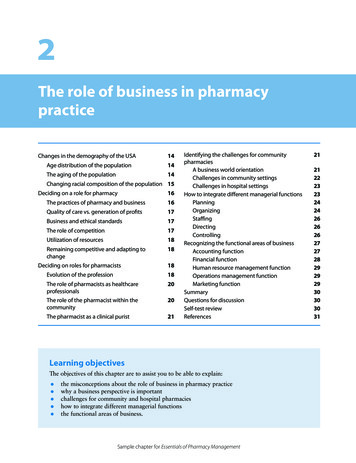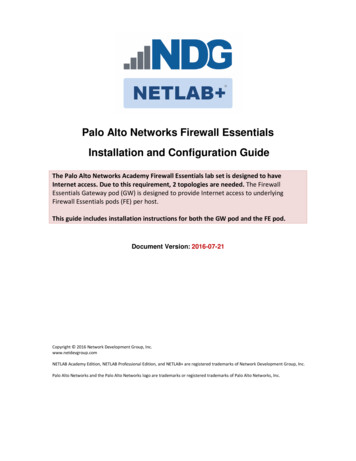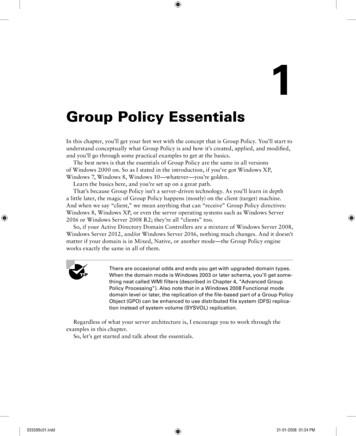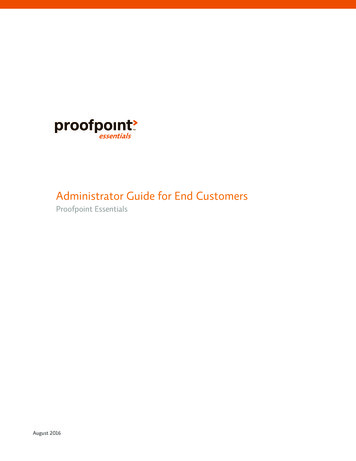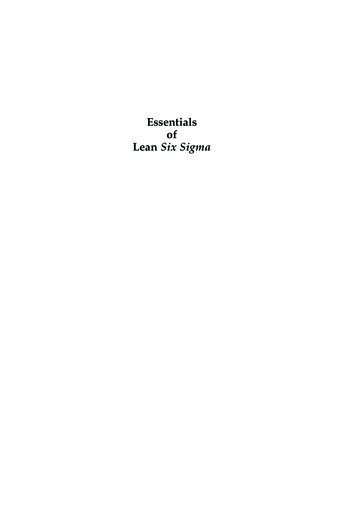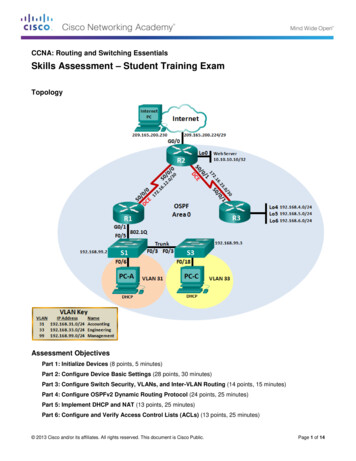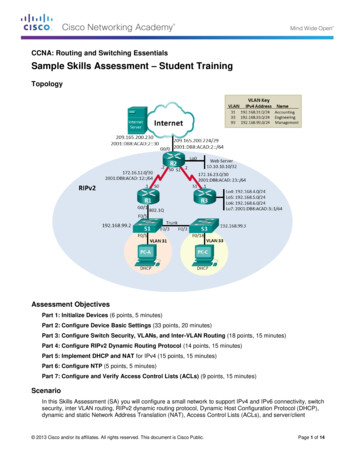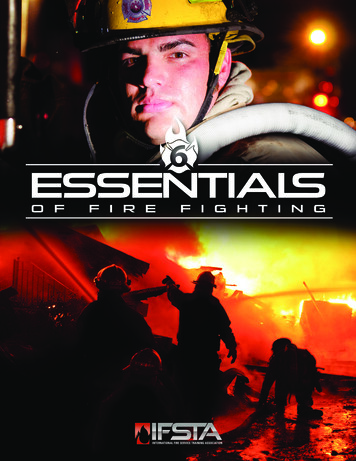
Transcription
ESSENTIALSO FF I R EF I G H T I N GINTERNATIONAL FIRE SERVICE TRAINING ASSOCIATION
Firefighter Personal Protective EquipmentChapter ContentsCase History.259Personal Protective Equipment.259Structural Fire Fighting Protective Clothing. 261Wildland Personal Protective Clothing. 270Roadway Operations Clothing. 273Emergency Medical Protective Clothing.274Special Protective Clothing.274Station/Work Uniforms. 276Care of Personal Protective Clothing. 277Donning from a Backup Mount. 300Donning the Facepiece. 301Doffing Protective Breathing Apparatus. 302Inspection and Maintenance of ProtectiveBreathing Apparatus.303Protective Breathing Apparatus Inspectionsand Care. 303Annual Inspection and Maintenance. 306Safety Considerations for PersonalProtective Equipment . 280SCBA Air Cylinder Hydrostatic Testing. 306Respiratory Protection.281Refilling SCBA Cylinders. 307Respiratory Hazards. 281Types of RespiratoryProtection Equipment. 287Replacing SCBA Cylinders.311Using Respiratory Protection Equipment.312Safety Precautions for SCBA Use.312Respiratory Protection Limitations. 295Exit Indicators and Techniques.313Storing Respiratory Protection Equipment. 296Chapter Summary.316Review Questions.316Skill Sheets.317Donning and Doffing ProtectiveBreathing Apparatus.297General Donning Considerations. 297Donning an Unmounted SCBA. 298Donning from a Seat Mount. 299256Donning from a Side or RearExternal Mount. 300Chapter 6 Firefighter Personal Protective Equipment
Chapter 6Key TermsAirborne Pathogens.287Air-Purifying Respirator (APR).284Asphyxiation.283Cascade System.307Closed-Circuit Self-Contained BreathingApparatus.298Code of Federal Regulations (CFR).293Fire Fighting Boots.267Gas.284Hearing Protection.270Helmet.264High-Efficiency Particulate Air(HEPA) Filter.287Hydrostatic Test.303Hypoxia.282Open-Circuit Self-ContainedBreathing Apparatus.289Oxygen-Deficient Atmosphere.282Particulate.283Permissible Exposure Limits (PEL).314Personal Alert Safety System (PASS).270Personal Protective Equipment (PPE).259Powered Air-Purifying Respirator (PAPR).284Protective Coat.266Protective Gloves.267Protective Hood.266Protective Trousers.267Proximity Fire Fighting.261Pulmonary Edema.283Qualitative Fit Test (QLFT).292Quantitative Fit Test (QNFT).292Respiratory Hazards.281Search Line.315Structural Fire Fighting.261Vapor.284NFPA Job Performance RequirementsThis chapter provides information that addresses the following job performance requirementsof NFPA 1001, Standard for Fire Fighter Professional Qualifications (2013).Firefighter I5.1.15.1.25.3.15.3.25.5.1Chapter 6 Firefighter Personal Protective Equipment257
Firefighter I Chapter Objectives1. Describe the purpose of personal protective equipment. (5.1.1)2. Describe characteristics of each type of personal protective equipment. (5.3.2)3. Summarize guidelines for the care of personal protective clothing. (5.1.1, 5.5.1)4. Explain the safety considerations for personal protective equipment. (5.3.1)5. Identify respiratory hazards. (5.3.1)6. Identify types of respiratory protection equipment. (5.3.1)7. Describe the limitations of respiratory protection equipment. (5.3.1)8. Explain methods for storing respiratory protection equipment. (5.5.1)9. Describe general donning and doffing considerations for protective breathing apparatus.(5.3.1)10. Summarize general considerations for protective breathing apparatus inspections and care.(5.1.1, 5.5.1)11. Summarize safety precautions for refilling SCBA cylinders. (5.5.1)12. Explain procedures for replacing SCBA cylinders. (5.3.1)13. Explain safety precautions for SCBA use. (5.3.1)14. Describe nonemergency and emergency exit indicators. (5.3.1)15. Describe nonemergency exit techniques. (5.3.1)16. Demonstrate the method for donning structural personal protective clothing for use at anemergency. (Skill Sheet 6-I-1, 5.1.2, 5.3.1)17. With structural personal protective clothing in place, demonstrate the over-the-head method ofdonning an SCBA. (Skill Sheet 6-I-2, 5.3.1)18. With structural personal protective clothing in place, demonstrate the coat method for donning anSCBA while seated. (Skill Sheet 6-I-3, 5.3.1)19. With structural personal protective clothing in place, demonstrate the method for donning anSCBA while seated. (Skill Sheet 6-I-4, 5.3.1)20. Doff personal protective equipment, including respiratory protection, and prepare for reuse. (SkillSheet 6-I-5, 5.1.2)21. Demonstrate the steps for inspecting an SCBA. (Skill Sheet 6-I-7, 5.5.1)22. Demonstrate the steps for cleaning and sanitizing an SCBA. (Skill Sheet 6-I-7, 5.5.1)23. Demonstrate the method for filling an SCBA cylinder from a cascade system, wearing appropriatePPE, including eye and ear protection. (Skill Sheet 6-1-8, 5.3.1)24. Demonstrate the method for filling an SCBA cylinder from a compressor/purifier system, wearingappropriate PPE, including eye and ear protection. (Skill Sheet 6-I-9, 5.3.1)25. Demonstrate the one-person method for changing an SCBA cylinder. (Skill Sheet 6-I-7, 5.3.1)26. Demonstrate the two-person method for changing an SCBA cylinder. (Skill Sheet 6-I-7, 5.3.1)258Chapter 6 Firefighter Personal Protective Equipment
Chapter 6Firefighter PersonalProtective EquipmentCase HistoryIn 2002, Mark Noble, a nineteen-year veteran of the Olympia (WA) Fire Department, wasdiagnosed with brain cancer. During his treatment, Mark began to research the connectionbetween firefighters and cancer. He learned that firefighters are exposed to highly toxicsubstances in virtually every fire and that some toxins can accumulate in the body afterrepeated exposures. These potentially deadly toxins include asbestos, benzene, polycyclicaromatic hydrocarbons (PAHs), polychlorinated biphenyls (PCBs), carbon monoxide (CO), andother products of combustion that are present during the overhaul phase of a fire.In his research, Mark found that firefighters are twice as likely as the general public to develop intestinal, liver,testicular, and prostate cancer, non-Hodgkin’s lymphoma, and malignant melanoma. They are three times as likelyto develop skin, brain, and bladder cancer, as well as leukemia. They are also four times as likely to develop kidneycancer (Figure 6.1, p.260).In 2005, Mark Noble died at the age of 47. The brain cancer that killed him was most likely caused by the toxins hewas exposed to in the fire service. Mark loved being a firefighter, but he said that if he had it to do over again, hewould wear his SCBA more, and he would be more conscientious about attaching exhaust collection hoses to theapparatus.Permission to use this information was granted by Mrs. Rebecca Noble and ERGOMETRICS & Applied PersonnelResearch, Inc., who produced a video interview with Mark during his final months. The video is available at thefollowing Website: www.ergometrics.org.As a firefighter and emergency responder, you will work in a wide variety of hazardous environments. To protect your life and health, you must wear proper safetyequipment at all times. This chapter provides an overview of two critical types ofsafety equipment: personal protective equipment (PPE) and respiratory protection.You will learn about the different types of this equipment, as well as their functions,proper usage, and maintenance.Personal Protective EquipmentPersonal protective equipment (PPE) is the personal protective clothing (PPC), respiratory protection equipment, and personal alert safety system (PASS) you will wearduring emergency responses. It is designed to protect you from hazards and minimizePersonal Protective Equipment(PPE) — General term for theequipment worn by fire andemergency services responders;includes helmets, coats, trousers,boots, eye protection, hearingprotection, protective gloves,protective hoods, self-containedbreathing apparatus (SCBA),and personal alert safety system(PASS) devices. Also known asBunker Clothes, Full StructuralProtective Clothing, ProtectiveClothing, Turnout Clothing, orTurnout Gear.Chapter 6 Firefighter Personal Protective Equipment259
Probability of Cancer Among FirefightersTimes as likely to develop0 1234IntestinalLiverProstateNon-Hodgkin’sLymphoma TesticularTypes of Cancer MalignantMelanoma Skin Bladder Leukemia Brain KidneyLegendGeneral AdultPopulationFirefightersFigure 6.1 Firefighters are exposed to a greater range and concentration of hazards thanthe general public, and they have a higher likelihood of several types of cancers because ofthat exposure.260Chapter 6 Firefighter Personal Protective Equipment
Figure 6.2 Protective equipment and clothing are tailored to the hazards that a firstresponder will face.the risk of injury or fatality (Figure 6.2). Your PPC includes helmets, coats, trousers,boots, eye protection, hearing protection, protective gloves, and protective hoods. Itsuse is mandated by NFPA 1500, Standard on Fire Department Occupational Safetyand Health Program, and all equipment must be designed and constructed based onNFPA standards. Design and construction requirements for SCBA and PASS devices are covered in NFPA 1981, Standard on Open-Circuit Self-Contained BreathingApparatus (SCBA) for Emergency Services, and NFPA 1982, Standard on PersonalAlert Safety Systems (PASS), respectively.Different emergency operations require different kinds of PPE. For example, someemergency types require full sets of PPE, including respiratory protection, while others require only protective clothing. Types of personal protective clothing include: Structural fire fighting protective clothingWildland fire fighting protective clothingStructural Fire Fighting —Activities required for rescue,fire suppression, and propertyconservation in structures,vehicles, vessels, and similar typesof properties.Roadway operations protective clothingEmergency medical protective clothingSpecial protective clothingStation and work uniformsStructural Fire Fighting Protective ClothingAll personal protective clothing designed for structural and proximity fire fightingmust meet the requirements of NFPA 1971, Standard on Protective Ensembles forStructural Fire Fighting and Proximity Fire Fighting. This standard addresses the requirements for helmets, coats, trousers, boots, eye protection, protective gloves, andprotective hoods.Proximity Fire Fighting —Activities required for rescue,fire suppression, and propertyconservation at fires that producehigh radiant, conductive, orconvective heat; includes aircraft,hazardous materials transport, andstorage tank fires.Chapter 6 Firefighter Personal Protective Equipment261
Figure 6.3 NFPA 1971regulates the clothingcomponents that comply withthe standard.NFPA 1971 requires that all components must include a permanent label thatshows compliance with the standard (Figure 6.3). This label contains the followingstatement:THIS STRUCTURAL FIRE FIGHTING PROTECTIVE (name of component)MEETS THE (name of component) REQUIREMENTS OF NFPA 1971,(current edition) EDITION.Labels must also include the following information: Manufacturer’s name, identification, or designationManufacturer’s addressCountry of manufactureManufacturer’s identification, lot, or serial numberMonth and year of manufactureModel name, number, or designSize or size rangePrincipal materials of constructionFootwear size and width (where applicable)Cleaning precautionsPersonal protective clothing components must be compatible with each other toprovide the level of protection intended by the NFPA standard. Each component isdesigned to protect you from specific hazards and may not protect you from othertypes of hazards. For instance, structural personal protective clothing offers no protection against many types of hazardous materials.Firefighters should never alter their protective clothing. Changing, adding, orremoving components may void the manufacturer’s warranty, affect your workers’compensation benefits, and endanger your life. Alterations include removing themoisture barrier or liner of coats and trousers, sewing hooks, loops, or clasps to theouter shell, and adding combustible decals to the helmet.CAUTIONUnauthorized alteration of your PPE may affect theworker’s compensation benefits provided to you byyour jurisdiction.262Chapter 6 Firefighter Personal Protective Equipment
Personal Protective C
NFPA standards. Design and construction requirements for SCBA and PASS de-vices are covered in NFPA 1981, Standard on Open-Circuit Self-Contained Breathing Apparatus (SCBA) for Emergency Services, and NFPA 1982, Standard on Personal Alert Safety Systems (PASS), respectively. Different emergency operations require different kinds of PPE .
